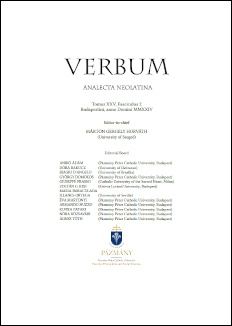Megjelent 2024-12-31
Kulcsszavak
- Erving Goffman,
- Franz Kafka,
- George Herbert Mead,
- Identity,
- Luigi Pirandello
Hogyan kell idézni
Copyright (c) 2025 Alberto Castelli

This work is licensed under a Creative Commons Attribution 4.0 International License.
Absztrakt
What emerges from the Twentieth-century is the relativity of external reality paralleled by the decomposition of the self. Identity is an unstable and nebulous concept that social constructionist theories have transformed into a series of external embodiments, hence reducing it to a myth. But when self-constituting ties are severed, identity begins to unravel. With Luigi Pirandello’s and Franz Kafka’s narrative, the self must be confirmed by the judgment of the Other. In the dynamic relationship between the “I” and the Other, Pirandello chooses the former, and Kafka the latter. With Pirandello, the individual becomes a madman, but with Kafka, the choice of the Other transforms the individual into a monster.
Hivatkozások
- Angus, Douglas (1954): Kafka’s Metamorphosis and ‘The Beauty and the Beast’ Tale. The Journal of English and Germanic Philology 53(1): 69–71. http://www.jstor.org/stable/27713629
- Bassanese, Fiora (1997): Understanding Luigi Pirandello. Columbia: USC Press.
- Brod, Max (1965): Franz Kafka: A Biography, trans. G. Humphreys Roberts. New York: Da Capo Press.
- Camus, Albert (1959): The Myth of Sisyphus, trans. Justin O’Brien. New York: Vintage Books.
- Canetti, Elias (1969): Der andere Prozefl: Kajkas Briefe an Felice. Munich: Hanser.
- Corngold, Stanley (1988): Franz Kafka: The Necessity of Form, Cornell University Press. http://www.jstor.org/stable/10.7591/j.ctt207g62q.9
- Dombroski, Robert (1992): Pirandello’s modernity: Epistemology and the Existential of Theatre. In: Antonio Giuliana Sanguinetti-Katz (eds.) Pirandello and the Modern Theatre. Canadian Society for Italian Studies. 23–24. https://doi.org/10.1017/CCOL0521660181.006
- Dombroski, Robert (2003): The Foundations of Italian Modernism: Pirandello, Svevo, Gadda. In: Peter Bondanella and Andrea Ciccarelli (eds.) The Cambridge Companion to the Italian Novel. Cambridge: Cambridge University Press. 89–103.
- Fiskin, A. M. I (1948): Luigi Pirandello: The Tragedy of the Man Who Thinks. Italica 25(1): 44–51. https://doi.org/10.2307/476716
- Gardair, Jean-Michel (2001): Jean-Michel Gardair legge Il Fu Mattia Pascal di Luigi Pirandello. Fossombrone: Metauro Edizioni.
- Goffman, Erving (1990): The Presentation of Self in Everyday Life. London: Penguin Books.
- Harrison, Thomas (1996): 1910: The Emancipation of Dissonance. Berkeley, CA: University of California Press. https://doi.org/10.1525/9780520341098
- Heffner, Hubert C. (1957): Pirandello and the Nature of Man. The Tulane Drama Review 1(3): 23–40. https://doi.org/10.2307/1124985
- Heselhaus, Clemens (1952): Kafkas Erziihlformen. Deutsche Vierteljabrsscbrift fiir Literaturwissenschaft und Geistesgeschichte 26: 353–376. https://doi.org/10.1007/BF03374848
- Janouch, Gustav (2012): Conversations with Kafka, trans. Goronwy Rees. New York: A New Directions Book.
- Kafka, Franz (1949): Diaries 1914–1923. In: Max Brod (ed.), trans. Martin Greenberg and Hannah Arendt. New York: Schocken.
- Kafka, Franz (1973): Letters to Felice, trans. James Stern and Elisabeth Duckworth. New York, Schocken.
- Kafka, Franz (1977): Letters to Friends, Family, and Editors, trans. Richard and Clara Winston. New York: Schocken.
- Kafka, Franz (1996): The Metamorphosis, trans. Stanley Corngold. New York: Norton.
- Kafka, Franz (2008): Letter to my Father, trans. Howard Colyer. North Carolina: Lulu.
- Krutch, Joseph Wood (1953): “Modernism” in the Modern Drama. Ithaca, New York: Cornell University Press.
- Locke, John (1959): Of Identity and Diversity. An Essay Concerning Human Understanding. Vol. I. New York: Dover. 439–470.
- Macchia, Giovanni (2000): Pirandello o la stanza della tortura. Milano: Mondadori.
- Masiello, Vitilio (1994): Pirandello: L’identità negata: Uno, nessuno, centomila. Belfagor 49(5): 519–533. http://www.jstor.org/stable/26147667
- Mead, George Herbert (1925): The Genesis of the Self and Social Control. International Journal of Ethics 35(3): 251–277. https://doi.org/10.1086/intejethi.35.3.2377274
- Melcer-Padon, Nourit (2015): Mattia Pascal’s Punitive Mask. Italica 92(2): 358–374. http://www.jstor.org/stable/43895972
- Pirandello, Luigi (1922): Henry IV, trans. Edward Storer. New York: E. P. Dutton.
- Pirandello, Luigi (1923): The Late Mattia Pascal, trans. Arthur Livingston. New York: E. P. Dutton.
- Pirandello, Luigi (1958): Maschere Nude. Vol. 1. Milan: Mondadori.
- Pirandello, Luigi (1990): One, None and a Hundred-thousand, trans. Samuel Putnam. Ravenio Books.
- Pirandello, Luigi (2014): The Wheelbarrow. In Tales of Madness, trans. Giovanni R. Bussino. Dante University Press.
- Pirandello, Luigi, and Teresa Novel (1966): On Humor. The Tulane Drama Review 10(3): 46–59. https://doi.org/10.2307/1125162
- Ryan, Michael P. (1999): Samsa and Samsara: Suffering, Death, and Rebirth in ‘The Metamorphosis.’ The German Quarterly 72(2): 133–152. https://doi.org/10.2307/408369
- Santayana, George (1922): Soliloquies in England and Later Soliloquies. New York: Scribner’s.
- Sartre, Jean-Paul (1956): Being and Nothingness, trans. Hazel E. Barnes. New York: Philosophical Library.
- Sartre, Jean-Paul, Michel Contat & Michel Rybalka (eds.) (1976): Sartre on Theater. London: Random House.
- Shakespeare, William & Arthur Wilson Verity (1925): As you like it. Yale University Press.
- Sokel, Walter H. (1956): Kafka’s ‘Metamorphosis’: Rebellion and Punishment. Monatshefte 48(4): 203–214. http://www.jstor.org/stable/30166165
- Somigli, Luca (2011): Italy. In: Pericles Lewis (ed.) The Cambridge Companion to European Modernism Cambridge: Cambridge University Press. 75–93. https://doi.org/10.1017/CCOL9780521199414.005
- Stets, Jan E. & Peter J. Burke (2000): Identity Theory and Social Identity Theory. Social Psychology Quarterly 63(3): 224–237. https://doi.org/10.2307/2695870
- Straus, Nina Pelikan (1989): Transforming Franz Kafka’s ‘Metamorphosis.’ Signs 14(3): 651–667. https://doi.org/10.1086/494528
- Stryker, Sheldon (1980): Symbolic Interactionism: A Social Structural Version. Menlo Park, CA: Benjamin Cummings.
- Subialka, Michael (2015): Modernism at War: Pirandello and the Crisis of (German) Cultural Identity. Annali d’Italianistica 33: 75–97. http://www.jstor.org/stable/43894795
- Sweeney, Kevin W. (1990): Competing Theories of Identity in Kafka’s ‘The Metamorphosis.’ Mosaic: A Journal for the Interdisciplinary Study of Literature 23(4): 23–35. http://www.jstor.org/stable/24780543
- Tilgher, Adriano (1923): Studi sul teatro contemporaneo. Roma: Libreria di Scienze e Lettere.
- Turner, John C., Michael A. Hogg, Penelope J. Oakes, Stephen D. Reicher & Margaret S. Wetherell (1987): Rediscovering the Social Group: A Self-Categorization Theory. New York: Basil Blackwell.


